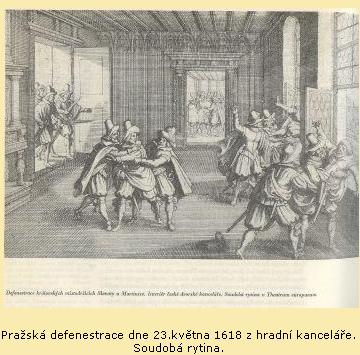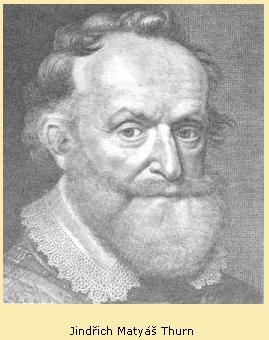Pěkný, jenom ten letopočet v druhém odstavci pod Bitvou na Bílé Hoře by chtěl opravit...
The Thirty Years' War No.1
Categories: Years of war and revolution , Třicetiletá válka
The Thirty Years' War
The Thirty Years' War was the first modern war in history. Although it began as a religious conflict between Catholics and Protestants, it ended as a struggle for power in Europe.
The Czech War (1618-1620), the Battle of White Mountain
The opening conflict of the Thirty Years' War was the Czech Estates' Revolt against the absolutism and religious intolerance of the Habsburg It was one of the key events in Czech and European history, as both estates sought support abroad. It began with the 3rd Prague Defenestration, the throwing of two governors out of the window of the court office of Prague Castle on 23 May 1618.
There followed several successes on the part of the Estates ("Bohemian Estates" were geographically Bohemian, the Moravian nobility did not participate in the uprising), but the suppression of the by Ferdinand II, and the Catholic League at the Battle of White Mountain near Prague in 1620, followed by the capture of a number of towns and the flight of the Estates' elected king, Frederick of Austria ( 1619 - 1620 ) from the country. The Estates' armies did not put up much resistance at White Mountain, although the forces were balanced on both sides. The reason for the defeat of the Estates was mainly due to their inconsistency, unconceptual policy and unwillingness to finance the army.The defeat led to a rapid progression of recatholization in the Czech lands and the ousting of the Estates from the top politicalAll power was thus in the hands of the monarch, who was supported by the Catholic Church.
Battle of White Mountain
When Maximilian of Bavaria entered the war, Ferdinand had two large armies at his disposal. The army of the League, commanded formally by Maximilian, but in reality by Field Marshal Tscherklas Tilly. It was composed of Walloons, Spaniards, Lorrainians, Germans, Croats, Dutch and Irish. This army consisted of 14 infantry and 5 cavalry regiments, about 25,000 infantry and 5,500 cavalry.
The Imperial Army itself, commanded by Field Marshal Buquoy, had 19 regiments of infantry, 5 regiments of cuirassiers, 12 regiments of arquebusiers, one regiment of hussars and 3 regiments of Cossacks. In all, 21,000 men, their numbers increasing as reinforcements kept arriving during the summer and autumn from various parts of the country other than the Austrians. This army could not operate on the Czech battlefield in its entirety, part of it had to be left as a reserve against the Hungarians, which is why no more than 12,000 men fought on White Mountain. It follows that Ferdinand had a total of about 33,000 men available in Bohemia.
The armies of the Czech-Austrian-Hungarian Confederation were divided into 4 army corps, which were differentiated according to who paid them. The best was the Anhalt Corps. Hohenlohe's infantry, Drum's cavalry. It was made up of 6 infantry and 8 cavalry regiments.The core was made up of the old regiments serving since 1918 (Thurn's, Hohenlohe's, Kupler's) , joined by new regiments : Upper and Lower Austrian and the Saxon-Weimar regiment. Two old Czech regiments (Oldrich Kinsky and Colonna of Fels) were also at the core. This corps had about 18,000 infantry and 4,000 cavalry. During the autumn campaign this number was halved and had to be supplemented by troops from other corps.
The second was the Moravian-Silesian army corps, of which Thurn was commander-in-chief. The Moravian Estates included 3 infantry and 4 cavalry regiments, a total of 3,000 infantry and 2,500 cavalry. The Silesian infantry was tasked with countering a possible invasion from the Polish side.
Another corps that operated in Bohemia was Mansfeld's army corps, part of which was stationed in Horní Falec. Of the 9 infantry regiments in Bohemia, there were two Mansfeld regiments, one Saxon - Weimar regiment, an Anglo-Scots regiment of Brother's , a Scottish regiment of Seton and a Dutch regiment of Franck, making a total of over 8,000 infantry and 1,000 cavalry. In point of nationality this corps was the most varied , two-thirds of the men being Dutch, Scotch and English, and the rest Germans.
The Fourth Army Corps was Hungarian and consisted of 7 regiments of cavalry (hussars) and only a small part of infantry. It had a total of about 6,000 men and the commander was János Bornemissa.
The United States Army had a total of 42,000 men, but barely half could be deployed for operations in Bohemia., because the Hungarian and Silesian-Moravian corps were tied to their countries, the losses of the Czech corps were great, losing about half of their men.
The opening of the last phase of the Bohemian War turned attention back to the Bohemian battlefield, for Maximilian was expected to invade Bohemia soon. The supervision of operations in Bohemia was entrusted to Thurn. When the Lower Austrians saw that the going was tough, they asked Frederick to take over their rule and protection at the Diet of Retz on 1 August.This belated move could have turned things around a year earlier, but it was too late now and had to be rejected in Prague given the overall situation. By that time the Ligist troops had already conquered Linz and thus Upper Austria. The first country of the Bohemian-Austrian-Hungarian federation was conquered.
Meanwhile, Mansfeld, when the demands of his regiments were at least partially satisfied, together with Thurn, after several months of actions (the capture of Chvalšin near Český Krumlov, the failed attempt to raid Budějovice), invaded Volary from Týn nad Vltavou and took possession of the 29th and 29th Lviv. On July 29th, the important fortifications on the Golden Trail. Another fortification was then built in Zhelnau, but the army did not attempt to capture it again, as the rapid movement of the Ligist troops in Upper Austria made Mansfeld's operational plan irrelevant. The original plan to link up with the Upper Austrians became irrelevant and even unworkable. Marradas had the border crossing at Freistadt seized in time. Mansfeld therefore withdrew to Protivín and from there moved on to Veselí nad Lužnicí and Jindřichův Hradec, in order to be closer to Anhalt's army corps, which was still at Eggenburg.
The Ligist troops lingered in Linz longer than expected. Sickness broke out in the army and it took some time before the revolt of the Upper Austrian Estates was put down. It was not until the 23rd of August that the army started on the march again, and according to the original plan it was to join with Buquoy's army, which was lying at Horn. The Estates army was then to be either defeated in battle or pushed back to Moravia, thus clearing the way for the combined armies to reach Bohemia and Prague.
However, the Ligist army headed first to Freistadt on the Bohemian border and on 27 August to Kaplice, from where the Bavarian duke sent a warning to Frederick and the Bohemian Estates against further resistance. He announced that he was coming to the country in the name of the Emperor. The campaign to Kaplice was apparently intended to confuse the Estates High Command and give the impression that the Bavarian army had given up the idea of joining with Buquoy. Suddenly, however, the Ligist army returned to Austria via Benesov, Stropnice, Vitoraz and Svetla and joined up with Buquoy on 8 September. Anhalt began to retreat towards the Moravian border to Drozd (Drosendorf), having previously weakened his army by several thousand men with useless garrisons in Horn, Eggenburg and Retz.
By this time the great European war had already begun, for on 10. September, the long-assembled army in the Spanish Netherlands, under Ambrosio Spinolly, granted the Falco, and on the following day the first encounter with the Union army had already taken place. The Falck war was set in motion.

Continued next time..........
Viky
The article is included in categories:
- Archive of articles > Years of war and revolution
- Archive of articles > Years of war and revolution > Třicetiletá válka
Post
maartine, který letopočet myslíš?
už to vidím, se omlouvám, sem se přepsala.Dík za připomínku
ta třicetiletá válka byla bitva na bílé hoře
prepis omlouvam se
Bitva na Bílé hoře byla první velkou bitvou Třicetileté války. Na dalších 300 let ovlivnila osud českého státu. Pobělohorská doba byla jedna z nejtěžších v historii.
Viky-prosím Tě,v jakém roce dobyli ty Chvalšiny?ps:a víš o tom víc ,jsem totiž z chvalšin.dík.
Viky-prosím Tě,v jakém roce dobyli ty Chvalšiny?ps:a víš o tom víc ,jsem totiž z chvalšin.dík.
To nevím, ale pokusím se to zjistit.
Tak jsem prošla knihovnu, internet a materiály co mám doma, ale nic jsem nenašla. Víc by o tom mohl vědět kronikář města nebo vychází většinou k nějakému výročí města knížka, kde je popsaná historie. Tak snad budeš mít víc štěstí než já a něco zjistíš.
ahojky..:-) fakt moooooc díky za referát mocinky mi pomoch ae prosimtě můžeš mi tu napsat nějaký zbráně, který se používali ve třicetileté válce..??? děkuju předem
ahojky..:-) fakt moooooc díky za referát mocinky mi pomoch ae prosimtě můžeš mi tu napsat nějaký zbráně, který se používali ve třicetileté válce..??? děkuju předem
Ahoj. Tady bys mohl něco najít www.lovecpokladu.cz/home/tricetileta-valka-vyzbroj-418
ste super kamos
to je dobre ten letopocet nauc se to lamakuna ty bili hore je bitva omg










